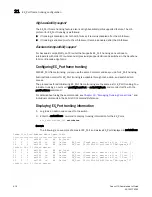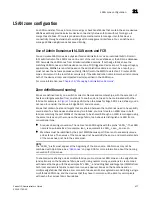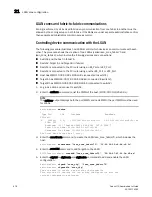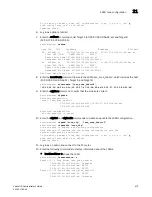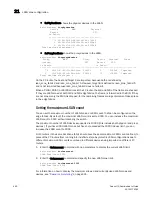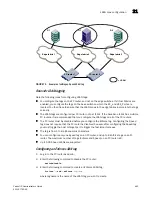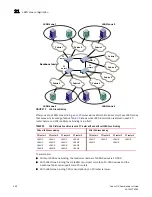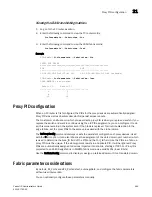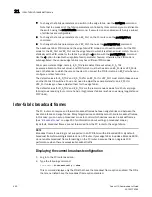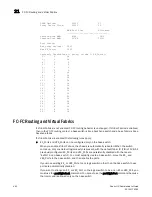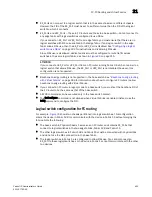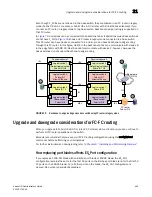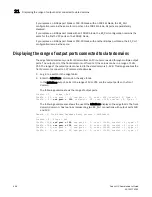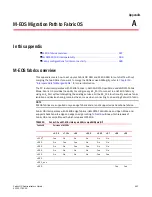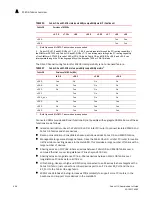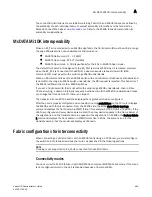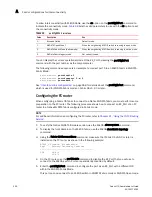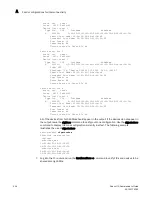
Fabric OS Administrator’s Guide
489
53-1001763-02
Proxy PID configuration
21
Viewing the LSAN zone binding matrixes
1. Log on to the FC router as admin.
2. Enter the following command to view the FC router matrix:
fcrlsanmatrix --fabricview -fcr
3. Enter the following command to view the LSAN fabric matrix:
fcrlsanmatrix --fabricview -lsan
Example
FCR:Admin>
fcrlsanmatrix --fabricview -fcr
SAVED FCR PAIRS
======================================================
FCR
FCR
------------------------------------------------------
10:00:00:60:69:c3:12:b2 (2)
10:00:00:60:69:c3:12:b3 (unknown)
FCR:Admin>
fcrlsanmatrix --fabricview -lsan
LSAN MATRIX is activated
Fabric ID
Fabric ID
--------------------------------------
4
5
4
7
10
19
Proxy PID configuration
When an FC router is first configured, the PIDs for the proxy devices are automatically assigned.
Proxy PIDs (as well as phantom domain IDs) persist across reboots.
The most common situation in which you would set a proxy PID is when you replace a switch. If you
replace the switch and want to continue using the old PID assignments, you can configure it to do
so; this value remains in the system even if the blade is replaced. To minimize disruption to the
edge fabrics, set the proxy PIDs to the same values used with the old hardware.
The fcrProxyConfig command displays or sets the persistent configuration of proxy devices. Used
with the -s
slot
option, it can also influence the assignment of the xlate domain port number (which
is used to determine the Area_ID field of the PID) and the Port_ID field. Like the PIDs in a fabric, a
proxy PID must be unique. If the
slot
argument results in a duplicate PID, it will be ignored. Proxy
PIDs are automatically assigned to devices imported into a fabric, starting at f001. For Proxy IDs
projected to an M-EOS edge fabric in McDATA fabric mode, use valid ALPAs (lower 8 bits).
Use the fcrXlateConfig command to display or assign a preferred domain ID to a translate domain.
Fabric parameter considerations
By default, EX_Ports and VEX_Ports detect, autonegotiate, and configure the fabric parameters
without user intervention.
You can optionally configure these parameters manually.
Summary of Contents for 53-1001763-02
Page 1: ...53 1001763 02 13 September 2010 Fabric OS Administrator s Guide Supporting Fabric OS v6 4 0 ...
Page 4: ...iv Fabric OS Administrator s Guide 53 1001763 02 ...
Page 24: ...xxiv Fabric OS Administrator s Guide 53 1001763 02 ...
Page 28: ...xxviii Fabric OS Administrator s Guide 53 1001763 02 ...
Page 32: ...xxxii Fabric OS Administrator s Guide 53 1001763 02 ...
Page 40: ...xl Fabric OS Administrator s Guide 53 1001763 02 ...
Page 42: ...2 Fabric OS Administrator s Guide 53 1001763 02 ...
Page 54: ...14 Fabric OS Administrator s Guide 53 1001763 02 High availability of daemon processes 1 ...
Page 74: ...34 Fabric OS Administrator s Guide 53 1001763 02 Basic connections 2 ...
Page 102: ...62 Fabric OS Administrator s Guide 53 1001763 02 Audit log configuration 3 ...
Page 214: ...174 Fabric OS Administrator s Guide 53 1001763 02 Management interface security 7 ...
Page 228: ...188 Fabric OS Administrator s Guide 53 1001763 02 Brocade configuration form 8 ...
Page 276: ...236 Fabric OS Administrator s Guide 53 1001763 02 Creating a logical fabric using XISLs 10 ...
Page 404: ...364 Fabric OS Administrator s Guide 53 1001763 02 ...
Page 440: ...400 Fabric OS Administrator s Guide 53 1001763 02 Performance data collection 17 ...
Page 480: ...440 Fabric OS Administrator s Guide 53 1001763 02 F_Port masterless trunking 19 ...
Page 494: ...454 Fabric OS Administrator s Guide 53 1001763 02 Buffer credit recovery 20 ...
Page 574: ...534 Fabric OS Administrator s Guide 53 1001763 02 Hexadecimal overview E ...


